by Joy Livingwell
Summary: Landscapes in different climates respond very differently to similar management. Management that doesn't suit the landscape is the leading cause of desertification worldwide.
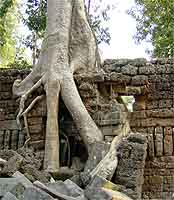 Prolonged rest heals nonbrittle landscapes. Jungle swallowed this abandoned temple in Cambodia. Joy Livingwell 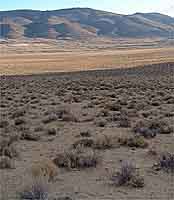 Prolonged rest desertifies brittle landscapes. Former grassland in Nevada, U.S.A.
|
The concept of brittleness was developed by Allan Savory to explain differences in how landscapes respond to disturbances such as grazing:
- In places such as England and eastern North America, land heals fastest when left undisturbed. Free of fire or grazers, it revegetates rapidly.
- In Africa, landscapes that fed wild herds of millions quickly desertify when grazed by just a few cattle.
The key difference is how these landscapes respond to prolonged rest (absence of disturbance).
Brittle or nonbrittle?
Where prolonged rest heals land, moisture is present throughout the year. Savory calls these areas nonbrittle.Areas where prolonged rest causes problems may have high or low rainfall, but all have a dry season. These areas are brittle.
Most areas lie somewhere between brittle and nonbrittle.
Brittleness is different from aridity. An arctic forest may need only a little moisture to remain damp throughout its short, cool growing season. By contrast, an 8-month dry season makes some parts of Africa very brittle in spite of 1500 mm (60 inches) rain per year.
Brittleness varies within landscapes. The windy, sun-baked top of a hill may be dry and brittle, while the bottom of the sheltered ravine below it stays damp year-round.
Nonbrittle areas
Thanks to constant moisture, nonbrittle areas have rapid decay. New plants establish easily, and bare ground quickly covers with vegetation.Constant moisture keeps decay organisms active throughout the growing season. Dead grass stems and twigs quickly rot at the base and fall over, producing natural mulch. Insects, fungi, and microorganisms work together to compost this material, and quickly turn it into new soil and plant food. The soil surface stays moist and easy to for seedlings to push through, and the damp earth keeps young plants from drying out.
Conventional range science originated mostly in nonbrittle and semi-brittle areas. It fails when transplanted to brittle landscapes because ecosystem processes work so differently there.
Brittle areas
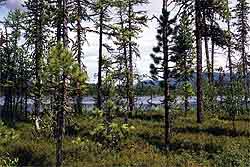 Brittleness is different from low rainfall. A short, cool growing season allows nonbrittle taiga to stay damp with just 300-500 mm (11-20") precipitation, most falling as snow. Siberia.
Joy Livingwell
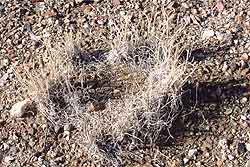 A grass plant dying from prolonged rest on a destocked range in Nevada, U.S.A. Accumulated dead leaves shaded and killed the center of the plant, leaving a typical donut shape.
Joy Livingwell
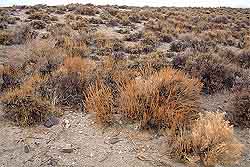 The healthiest plants on this overrested range are by the road, where they get disturbed by grading. Nevada. |
Because of long dry periods, brittle areas have slow decay. New plants have a hard time establishing, and bare ground is difficult to vegetate.
Dry periods cause decay organisms to die off during part of the year. Without active decay, dead growth may stand for years or decades, trapping nutrients and shading growing parts of the plant. Unmulched soil between plants often dries into a hard cap (crust) that seedlings can't push through. Young plants are likely to dry out before their roots get deep enough to find reliable moisture.
Yet many of the world's most productive landscapes are brittle or semi-brittle, including Africa's Serengeti and North America's deep-soiled prairies. What's nature's secret?
In brittle and semi-brittle areas, nature depends on animals to plant, mulch, and compost. These areas are or were home to vast numbers of herding grazers, such as wildebeest, springbok, and bison. Pack-hunting predators kept them bunched and moving.
A bunched herd tramples dead vegetation into mulch that protects the soil surface and keeps it moist. Hooves break soil crusts and plant seeds deeply enough to survive dry periods. The grazers' digestive systems provide year-round composting that recycles vegetation into high-quality fertilizer.
Brittleness affects land management
The distinction between brittle and nonbrittle environments is crucial because management that works in nonbrittle areas destroys brittle landscapes.Nonbrittle areas thrive on prolonged rest. Bare ground quickly covers with vegetation, and if the climate is right, a forest soon springs up.
Brittle areas need disturbance to recycle standing dead vegetation into mulch, plant seeds, and break soil caps that keep air and water out of the soil. Plants in these areas depend on periodic grazing to remove their standing dead growth, which then becomes new soil.
Because of the obvious damage livestock do if left in one place too long, people often try to heal brittle landscapes by reducing or eliminating grazing animals. This may produce temporary improvement, but in the long run rest desertifies brittle land.
On the other hand, periodic grazing and trampling followed by adequate recovery periods keeps brittle land healthy. This is how nature manages these landscapes -- with herds that move and migrate, grazing and trampling heavily but then moving on.
How to tell if a landscape is brittle or nonbrittle
These columns describe extremes. Most areas lie somewhere between brittle and nonbrittle.
| Nonbrittle | Brittle | |
|---|---|---|
| Always humid while above freezing | Long dry periods | |
| Dependable moisture throughout the year | The year is divided into wet and dry seasons | |
| In most years rainfall is close to average | Rainfall is often far above or far below average | |
| Rapid biological decay; dead growth rots from the bottom and falls over | Slow decay by weathering at the tips of twigs and grasses; dead growth may stand for years or decades, turning gray with age | |
| Rested land heals from damage (bare ground returns to forest) | Prolonged rest damages and desertifies land; animal impact (the intense trampling and dunging of animals in a tight herd) heals it | |
| Vegetation grows nearly everywhere, on roofs and gutters, on rocks and vertical banks, even on window glass | Bare surfaces are difficult to vegetate and steep banks may remain bare of even algae for decades | |
| Closely spaced grasses, with individual plants often hard to distinguish. | Strongly clumped grasses, often widely spaced | |
| Heavy overgrazing produces tight plant cover in a near monoculture, resembling a lawn; small bare areas may develop near points of extreme concentration | Heavy overgrazing produces bare ground between plants, but plant spacing is controlled mainly by amount of animal impact, which plants seeds. | |
| Few big herbivores that are solitary or live in small bands (tapir, okapi, gorilla, moose) | Many big herbivores forming large herds (bison, wildebeest, zebra) | |
| Solitary predators (tigers, cougars) | Pack-hunting predators (lions, wolves) |
Brittleness scale
Savory places landscapes on an arbitrary brittleness scale from 1 (very nonbrittle) to 10 (very brittle). He emphasizes that this scale is not precise -- the important thing is whether you are dealing with a brittle, semi-brittle, or nonbrittle environment, because that's what affects the land's response to management.
| 1 | 2 | 3 | 4 | 5 | 6 | 7 | 8 | 9 | 10 | ||||||||||
| very nonbrittle | nonbrittle | semi-brittle | brittle | very brittle | |||||||||||||||
Brittleness-productivity scale
Recently Jim Howell developed a brittleness/productivity scale that does more to explain the management differences between biomes:| Non-brittle | Semi-brittle | Brittle | |
|---|---|---|---|
| High annual production | Tropical rainforests | Subtropical and temperate tall-grass prairies | High-rainfall tropical savannas |
| Temperate rainforests | Mid-rainfall tropical savannas | ||
| Medium annual production | Mild temperate forests | Mild and cold temperate mid-grass prairies | Low-rainfall tropical savannas |
| Cold temperate forests | Mild and cold temperate steppe grasslands and shrublands | ||
| Low annual production | Subarctic coniferous forests | Tundra and alpine grasslands | True deserts -- tropical, mild, cold, arctic |
Jim's scale gives managers more detailed information about what their land needs and how to manage it. For instance, the main issue in a high-production brittle environment is getting enough grazing and trampling to prevent dead plant material from building up. In low-production brittle environments, giving plants sufficient recovery periods between grazings is more important. Read Jim's article for more details.
|
Allan Savory
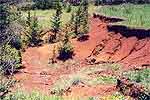 August 1999. Kelly Pasztor 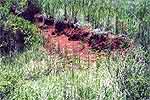 July 2001. Even severe gullying can be healed by managed grazing and trampling. More environmental restoration successes
|
A few decades ago, the concept of brittleness was unknown. Understanding it helped unravel the age-old mystery of desertification. Today this new knowledge is helping people around the world reverse desertification and restore damaged land. As humanity comes to understand more about how nature works, we can restore nature's productivity and health, and thus sustain ourselves and future generations.
Related articles and links